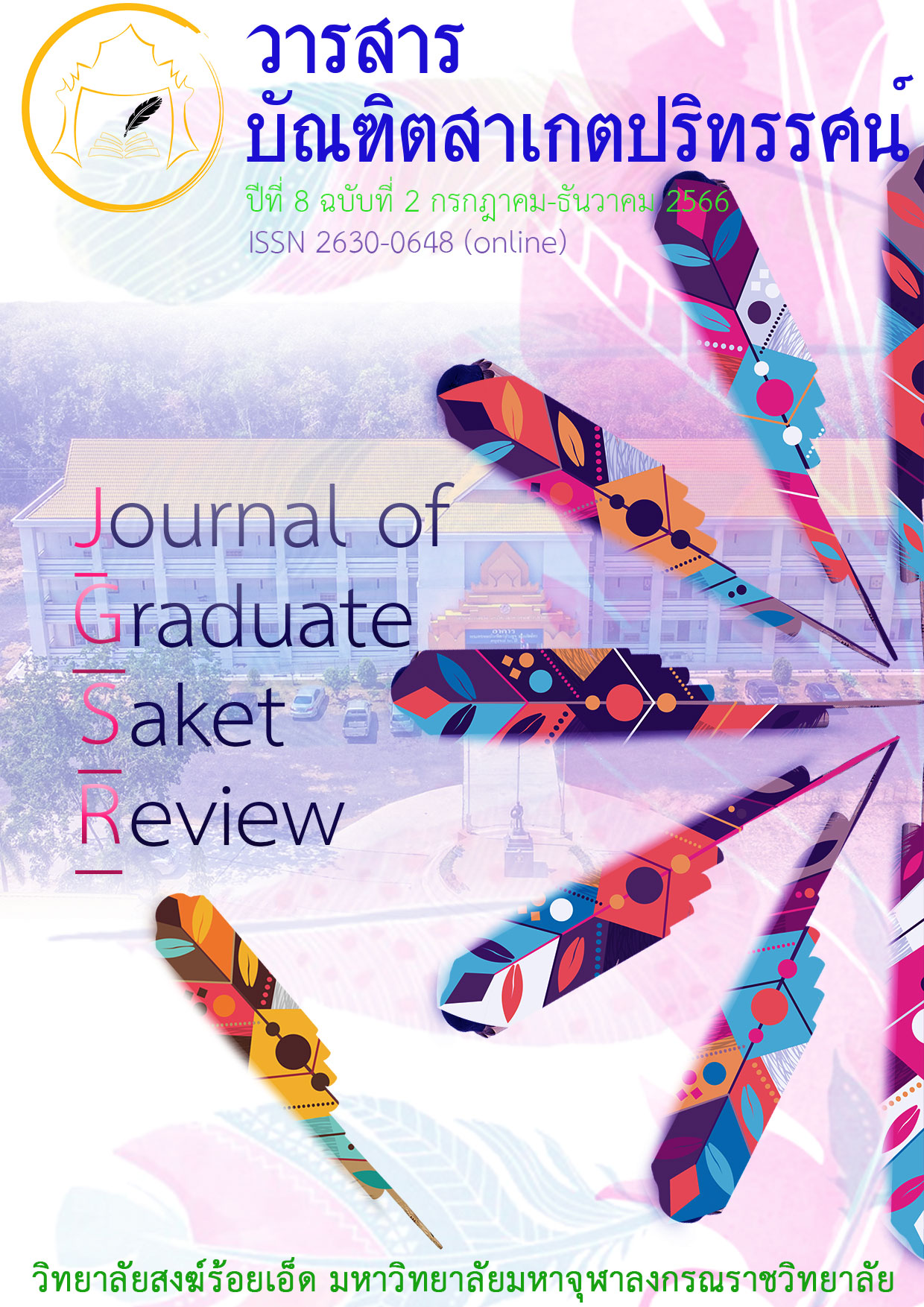การศึกษาวิเคราะห์ความงามของหลวงปู่โชคชัยโนนขวาง จังหวัดร้อยเอ็ด ตามหลักสุนทรียศาสตร์
Main Article Content
บทคัดย่อ
ทความวิจัยนี้วิจัยมีวัตถุประสงค์ 1) เพื่อศึกษาประวัติหลวงปู่โชคชัยโนนขวาง จังหวัดร้อยเอ็ด 2) เพื่อศึกษาความงามในทางสุนทรียศาสตร์ และ 3) เพื่อวิเคราะห์ความงาม หลวงปู่โชคชัยโนนขวาง จังหวัดร้อยเอ็ด ตามหลักสุนทรียศาสตร์ เป็นการวิจัยเชิงคุณภาพ โดยศึกษาจากคัมภีร์พระพุทธศาสนา เอกสารทางวิชาการ และงานวิจัยที่เกี่ยวข้อง เครื่องมือวิจัย ใช้การสัมภาษณ์จำนวน 40 คน แล้วนำเสนอผลการวิจัยด้วยวิธีการวิเคราะห์เชิงพรรณนา
ผลการวิจัยพบว่า:
หลวงปู่โชคชัยโนนขวางเป็นองค์พระพุทธรูปปางมารวิชัย มีขนาดหน้าตัก 40 นิ้ว มีอายุในสมัยสุโขทัยหรืออยุธยาตอนต้น นั่งประดิษฐ์อยู่บนแท่นในท่าขัดสมาธิ ด้วยพระกร(มือ)ด้านซ้ายวางหงายฝ่ามือไว้ที่หน้าตัก พระกร(มือ)ด้านขวาวางคว่ำฝ่ามือไว้บนพระชานุ(เข่า) พระกรรณยาน(หู) พระเกศมีเปลวแหลม เรียกว่า “หลวงปู่โนนบ้านเก่า” และ “หลวงปู่โนนขวาง” ต่อมาเรียกว่า “หลวงปู่โชคชัยโนนขวาง” เพราะประชาชนมาขอพรได้ผลตามความปรารถนาเป็นส่วนมาก เช่น สิ่งของสูญหาย ขอบุตรชาย เป็นต้น ซึ่งจัดเป็นพุทธคุณหลวงปู่โชคชัยโนนขวาง สุนทรียศาสตร์ (ความงามและสิ่งดีงาม) ในศิลปะและในธรรมชาติ เป็นศาสตร์ที่แสวงหาคำตอบของความงาม ประสบการณ์รับรู้ความงาม และตัดสินคุณค่าความงาม เพราะสรรพสิ่งมีภาวะความงามและมีรูปแบบความงามอยู่เสมอ พร้อมให้คุณค่าทางอารมณ์และความรู้สึกส่วนตัวของบุคคลหนึ่งๆ ตามหลักสุนทรียศาสตร์แล้วหลวงปู่โชคชัยโนนขวางมีความงามอยู่ 2 ส่วน คือ 1) ส่วนที่เป็นรูปธรรม ได้แก่ ความงามที่เกิดจากวัตถุ เนื่องด้วยหลวงปู่โชคชัยโนนขวางเป็นสิ่งที่สร้างจากก้อน ดินเหนียว มีรอยเผาไม่ค่อยสุกดี แต่ก็เป็นบ่อเกิดแห่งความรู้สึกถึงความงามทางศิลปะและทางธรรมชาติเมื่อได้พบเห็น และ 2) ส่วนที่เป็นนามธรรม ได้แก่ ความรู้สึกนึกคิด รับรู้ความงาม และคุณค่าความงามที่นำไปสู่ความเลื่อมใสศรัทธา ทั้งนี้ เพราะมนุษย์มีธรรมชาติความงามอยู่ภายในนั่นเอง
Article Details

This work is licensed under a Creative Commons Attribution-NonCommercial-NoDerivatives 4.0 International License.
เนื้อหาและข้อมูลในบทความที่ลงตีพิมพ์ในวารสารบัณฑิตสาเกตปริทรรศน์ ถือเป็นข้อคิดเห็นและความรับผิดชอบของผู้เขียนบทความโดยตรงซึ่งกองบรรณาธิการวารสาร ไม่จำเป็นต้องเห็นด้วย หรือร่วมรับผิดชอบใด ๆบทความ ข้อมูล เนื้อหา รูปภาพ ฯลฯ ที่ได้รับการตีพิมพ์ในวารสารบัณฑิตสาเกตปริทรรศน์ ถือเป็นลิขสิทธิ์ของวารสารบัณฑิตสาเกตปริทรรศน์ หากบุคคลหรือหน่วยงานใดต้องการนำทั้งหมดหรือส่วนหนึ่งส่วนใดไปเผยแพร่ต่อหรือเพื่อกระทำการใด ๆ จะต้องได้รับอนุญาตเป็นลายลักอักษรจากวารสารบัณฑิตสาเกตปริทรรศน์ ก่อนเท่านั้น
References
ของณัฐชยา จิตภักดี และ พระครูภาวนาโพธิคุณ. (2563). การแสวงหาคำตอบศิลปะและความงาม : สุนทรียศาสตร์ตะวันตก. วารสารบัณฑิตศึกษามหาจุฬาขอนแก่น. 7(4), 58-67.
ไพบูลย์ เสียงก้อง. (2555). พระพุทธศาสนามรดกล้ำค่าของไทย. กรุทเทพมหานคร: เฟื่องฟ้าปริ้นติ้ง จำกัด.
ยุพารักษ์ ชนะบวรวัฒน์. (2560). การบนสิ่งศักดิ์สิทธิ์ของชาวพุทธในสังคมไทย. วิทยานิพนธ์ศิลปศาสตรมหาบัณฑิต. สาขาวิชาพุทธศาสนศึกษา คณะศิลปะศาสตร:์ มหาวิทยาลัยธรรมศาสตร์.
วิโรฒ ศรีสุโร. (2543). บันทึกอีสานผ่านเลนส์. กรุงเทพมหานคร : สำนักงานคณะกรรมการวัฒนธรรมแห่งชาติ.
สมเด็จกรมพระยาดำรงราชานุภาพ. (2508). ตํานานพระพุทธเจดีย์. กรุงเทพมหานคร: กรมศิลปากร.
สุชาติ เกษประสิทธิ์. (2546). สุนทรียศาสตร์กับความเป็นมนุษย์. วารสารมุมศิลปะ. 24(3), 30-43.
Kasetprasit S.. (2003). Aesthetics and humanity. Art Corner Journal. 24(3), 30-43.
Jitpakdee N. and Phrakhrubhavanabodhiguna. (2020). Answer seeking on the arts and aesthetics : western aesthetics. Journal of Graduate MCU KhonKaen Campus. 7(4), 58-67.
Siangkong P.. (2012). Buddhism, Thailand's precious heritage. Bangkok: Fueangfa Printing Company Limited. Somdet Krom Phraya Damrong Rajanubhab. (1965). Legend of the Buddha Chedi. Bangkok : Fine Arts Department.
Srisuro W.. (2000). Recording Isaan through the lens. Bangkok: Office of the National Culture Commission.
Chanabowornwat Y.. (2017). The Buddhists’ vows to the sacred in thai society. Master of Arts. Thesis in Buddhist Studies Faculty of Liberal Arts: Thammasat University.

